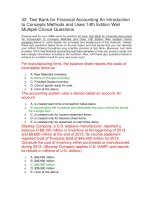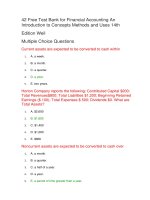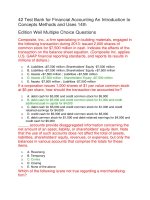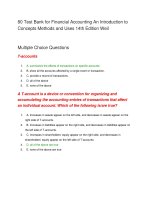Managerial accounting and introduction to concepts methods and user 11e by maher chapter 13
Bạn đang xem bản rút gọn của tài liệu. Xem và tải ngay bản đầy đủ của tài liệu tại đây (387.88 KB, 27 trang )
CHAPTER 13
PowerPoint Presentation by
LuAnn Bean
Professor of Accounting
Florida Institute of Technology
Allocating Costs
To Responsibility
Centers
© 2012 Cengage Learning. All Rights Reserved. May
not be copied, scanned, or duplicated, in whole or in
part, except for use as permitted in a license
distributed with a certain product or service or
otherwise on a password-protected website for
classroom use.
Managerial Accounting 11E
Maher/Stickney/Weil
☼
CHAPTER GOAL
Chapter 13 discusses concepts and methods
of assigning indirect costs such as
overhead, to departments. Additionally,
service department cost allocation and
joint-process cost allocation are
explained.
☼
LO 1
DIRECT
DIRECT COST:
COST: Definition
Definition
Is one that firms can identify
specifically with, or trace
directly to a particular product,
department, or process.
LO 1
INDIRECT
INDIRECT COST:
COST: Definition
Definition
Results from joint use of a
facility or service by several
products, departments, or
processes.
LO 1
MANAGERS WANT TO KNOW!
What are common costs?
Common costs are indirect
costs that cannot be
identified by a cost object.
LO 1
MANAGERS WANT TO KNOW!
Why allocate indirect
costs to products?
Full product costs should
be known, including
allocated indirect costs, for
pricing and planning
decisions.
LO 2
SERVICE DEPARTMENT
Service department costs, a source of
indirect costs, should be charged to users
because:
These costs should be covered by the
contribution margin of revenue-generating
departments
User departments must be aware of what
costs their department must cover
User departments should not treat service
departments as if they are free
LO 3
COST ALLOCATION
The cost allocation process has three steps:
1) Assign direct costs to departments
2) Allocate indirect costs to departments
3) Allocate service department costs to
production departments
F
B
LO 3
EXAMPLE: First Bank
First Bank (FB) has 4 departments. Production
departments are the Commercial Department
and the Personal Department. Service
departments are Computer Services and
Processing.
Indirect costs are allocated to each department.
Service department costs are allocated to
production departments in order to properly
price their products.
Continued
LO 3
F
B
What
Whatdepartment
department
would
wouldbe
be
responsible
responsiblefor
forcost
cost
allocation
allocationand
and
preparing
preparing
accounting
accounting
reports
reportsfor
for
managerial
managerialuse?
use?
EXHIBIT 13.1
LO 3
F
B
Step
Step1:
1:
Distribute
Distribute
direct
directoverhead
overhead
costs
costs. .
EXHIBIT 13.2
LO 3
F
B
Step
Step2:
2:
Allocate
Allocate
indirect
indirect
overhead
overhead
costs
costs. .
EXHIBIT 13.2
F
B
LO 3
ALLOCATION
First
First Bank
Bank has
has four
four indirect
indirect costs:
costs: security,
security,
property
property taxes,
taxes, rent
rent and
and utilities
utilities and
and
miscellaneous.
miscellaneous. When
When allocating
allocating
indirect
indirect costs,
costs, First
First Bank
Bank must
must select
select aa
cost
cost driver
driver for
for each
each indirect
indirect cost,
cost,
although
although miscellaneous
miscellaneous costs
costs may
may not
not
have
have aa cost
cost driver.
driver.
LO 3
F
B
Cost
Costdrivers
driversfor
for
First
FirstBank’s
Bank’s
indirect
indirectcosts.
costs.
Miscellaneous
Miscellaneous
costs
costswill
willbe
be
allocated
allocated
evenly.
evenly.
EXHIBIT 13.4
LO 3
F
B
EXHIBIT 13.5
Example:
Example:
proportionate
proportionate
allocation
allocationof
of
indirect
indirectcosts
costs
based
basedon
on
department
departmentuse
use
of
ofindirect
indirect
costs.
costs.
LO 3
Allocation
Allocationof
of
security
securitycosts
coststoto
four
four
departments.
departments.
Cost
Costdriver:
driver:##of
of
security
securityvisits.
visits.
EXHIBIT 13.6
LO 3
Allocation
Allocationof
of
property
propertytax
tax
costs
coststotofour
four
departments.
departments.
Cost
Costdriver:
driver:book
book
value
valueof
ofassets.
assets.
EXHIBIT 13.6
LO 3
Allocation
Allocationof
of
rent
rentand
andutilities
utilities
totofour
four
departments.
departments.
Cost
Costdriver:
driver:floor
floor
space.
space.
EXHIBIT 13.6
LO 3
Step
Step3:3:Allocate
Allocateservice
service
department
departmentcosts
coststotoproduction
production
departments.
departments.
EXHIBIT 13.2
LO 3
MANAGERS WANT TO KNOW!
How should service
department costs be
allocated?
Service department costs
should be allocated by one
of three methods: direct,
step, or reciprocal.
SERVICE DEPARTMENT
ALLOCATIONS
Under
Under the
the direct
direct method,
method, service
service department
department
costs
costs are
are only
only allocated
allocated to
to production
production
departments.
departments.
Under
Under the
the step
step method,
method, service
service department
department
costs
costs are
are sequentially
sequentially allocated
allocated to
to other
other
service
service departments
departments pro
pro rata
rata and
and finally
finally to
to
production
production departments.
departments.
The
The reciprocal
reciprocal method
method employs
employs matrix
matrix algebra
algebra
to
to simultaneously
simultaneously allocate
allocate all
all department
department
costs
costs to
to each
each other.
other.
LO 3
MARKETING and
ADMINISTRATIVE COSTS
Allocating
Allocating marketing
marketing and
and administrative
administrative
costs
costs and
and finding
finding aa basis
basis for
for allocation
allocation
are
are difficult.
difficult. They
They are
are separate
separate from
from
overhead
overhead costs
costs that
that are
are allocated
allocated to
to
production
production departments.
departments. But
But allocation
allocation
is
is important
important for
for pricing
pricing and
and planning
planning
decisions.
decisions.
LO 5
LO 6
JOINT
JOINT PROCESS:
PROCESS: Definition
Definition
Simultaneously converts
common input into several
outputs.
Example: timber logs are processed into
lumber of various grades and sizes.
LO 6
SPLITOFF
SPLITOFF POINT:
POINT: Definition
Definition
Is the stage of processing
when two products are
separated.
LO 6
The NRV method implies a matching of
input costs with revenues generated by
each output.
The physical quantities method is used when
output product prices are highly volatile
or when significant processing occurs
between split off and the 1st point
of marketability.









